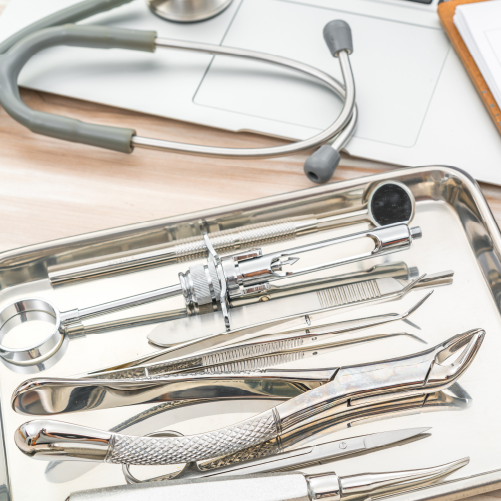Medical Applications
Medical
Long and intricate suppliers and the criticality of tracing every component in this long chain makes permanent marking a crucial necessity of the medical industry. The industry is vulnerable to disasters and uses multiple metal surfaces from stainless steel to aluminium to titanium requiring precision marking techniques to trace components. Laser marking is key to the medical industry as the parts meet highest standards of quality and safety and the marking should be readable to the human eye as well as scanners.
Surfaces For Marking
Day and night markings on avionic panels |micro and major electrical, mechanical and electronic constituents | Chips, circuit boards and other navigation devices | wings and blades | thrusters and actuators | branding and bar coding on exteriors

In the medical industry, both dot peen marking and laser marking machines are widely utilized for marking and identifying medical devices, instruments, and components. These technologies play a crucial role in ensuring traceability, compliance with regulations, and maintaining the quality and safety of medical products. Here’s an overview of how dot peen and laser marking machines are used in the medical field:
### Dot Peen Marking:
- Marking Process:
– Dot peen marking involves using a stylus to create a series of small, closely spaced dots on the surface of a material, forming alphanumeric characters, logos, or other symbols.
- Materials:
– Dot peen is suitable for marking various materials, including metals, plastics, and some medical-grade materials.
- Applications:
– Unique device identification (UDI) marking for compliance with regulatory requirements.
– Part numbering for traceability.
– Date codes, lot numbers, and expiration dates.
– Logo and branding on medical devices.
- Advantages:
– Durable and indelible markings.
– Well-suited for marking on materials with uneven surfaces.
– Compliance with medical industry regulations.
– Cost-effective for certain applications.
### Laser Marking:
- Marking Process:
– Laser marking involves using a laser beam to modify the surface of a material, creating high-contrast and permanent marks without physical contact.
- Materials:
– Laser marking is versatile and can be applied to a wide range of medical-grade materials, including metals, plastics, glass, and ceramics.
- Applications:
– UDI marking for traceability and compliance with regulatory standards.
– 2D matrix codes for part tracking.
– Fine and detailed markings for surgical instruments and implants.
– Laser engraving for serial numbers and logos.
- Advantages:
– High precision and fine detail.
– Non-contact process, reducing contamination risks.
– Flexibility in terms of design and customization.
– Suitable for sterile environments.
### Integration in Medical Device Production:
- Regulatory Compliance:
– Both dot peen and laser marking technologies are employed to meet regulatory requirements for medical device identification and traceability.
- Quality Assurance:
– Markings serve as a quality control measure, ensuring that each medical device meets the required standards.
- Traceability:
– The ability to trace medical devices throughout their lifecycle is crucial for safety and recall purposes, and both marking technologies facilitate this.
- Sterile Environments:
– Laser marking, in particular, is suitable for applications in sterile environments as it doesn’t involve physical contact and minimizes the risk of contamination.
In summary, both dot peen and laser marking machines are essential in the medical industry for marking and identifying medical devices. The choice between the two technologies depends on specific material requirements, precision needs, and the nature of the markings desired for a particular medical application.

